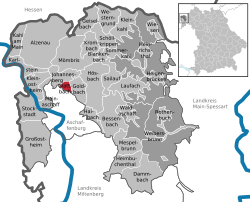Glattbach
| Glattbach | ||
|---|---|---|
|
||
| Coordinates: 50°00′20″N 09°08′50″E / 50.00556°N 9.14722°ECoordinates: 50°00′20″N 09°08′50″E / 50.00556°N 9.14722°E | ||
| Country | Germany | |
| State | Bavaria | |
| Admin. region | Unterfranken | |
| District | Aschaffenburg | |
| Government | ||
| • Mayor | Fridolin Fuchs (CSU) | |
| Area | ||
| • Total | 3.54 km2 (1.37 sq mi) | |
| Elevation | 182 m (597 ft) | |
| Population (2015-12-31) | ||
| • Total | 3,295 | |
| • Density | 930/km2 (2,400/sq mi) | |
| Time zone | CET/CEST (UTC+1/+2) | |
| Postal codes | 63864 | |
| Dialling codes | 06021 | |
| Vehicle registration | AB | |
| Website | www.glattbach.de | |
Glattbach is a community in the Aschaffenburg district in the Regierungsbezirk of Lower Franconia (Unterfranken) in Bavaria, Germany. It has around 3,300 inhabitants.
The community lies in a valley north of Aschaffenburg on the western edge of the Spessart (range).
In the 12th century, the forest still reached the town gates at Aschaffenburg. In the dales, in humble settlements, lived the Mainz Archbishop’s serfs who busied themselves in forestry and lived by hunting and working small farms. Out of one such settlement grew the village of Glattbach over the course of the centuries (earlier known as Gladebach and also Gladbach). It might have got its name from the goldlike glittering in the local stone found on the banks and on the bed of the brook (glad meant “glittering”, and Bach is German for “brook”). The economic relationships were quite humble; obligatory service, tithe payments and debts thwarted any growth. The only wealth came with the vineyards, which lay on the sunny south and southwest slopes. Cadastral names such as Wingert unterm Dorf, Wingert oberm Dorf and Am heißen Stein still recall the local winegrowing today. Since Glattbacher wine was known to be good, it led to Count Schönborn owning a vineyard here. After many bad harvests, the vines were torn up in the late 18th century, and instead intensive fruitgrowing began. This specifically involved cherries. In industry, linen weaving was strongly represented. In 1832, seventeen linen weavers appeared in the old community books.
The endless sharing out of estates under Electoral Mainz inheritance law meant that the area of land available for each farmer to work was forever shrinking. While only ten families shared the 310 ha municipal area in 1661, by the mid 18th century there were 50 neighbours (or Nachbarn, as residents were called, as opposed to those who had moved to the community and therefore neither owned land nor had rights) who had to eke out their lives from the soil.
...
Wikipedia



